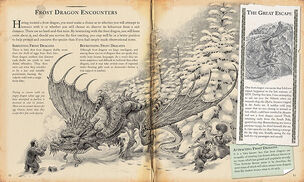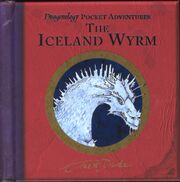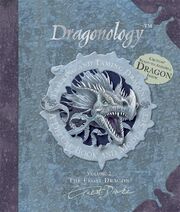|
"Unlike most dragons. Frost Dragons Eggs need to be kept in extremely low temperatures in order to hatch." - Dr. Ernest Drake |
x frost dragon(Draco Occidentalis Maritimus) | |
|---|---|
| Biographical information | |
| Ology | Dragonology |
| Genus | Draco |
| Age Span | Unrevealed |
| Rang | Artic and Antartic regions |
| Physical Colorations | |
| Feelers Color | None |
| Scale color | Pure White with either a pink or blue tinge |
| Antlers | White |
| Species Relationships | |
| Intraspecies Relationships | Good |
| Interspecies Relationship | Good |
| Natural Allies | Unrevealed |
| Natural Enemies | None |
| Reproduction | |
|
Method |
|
| Protection |
|
| Description |
|
| Hatching Key |
Icy Temeratures |
| Hatching Location | Somewhere with extremely cold temperatures |
| Draco Species Profile | |
| Species | Occidentalis |
| Subspecies | Martimus |
| Infraspecies | Magnus; unrevealed others |

The Iceland Wyrm's eggs had to be saved in this adventure.

This book is the most comprehensive Frost Dragon guide.
The Frost Dragon(Draco occidentalis maritimus.) is seldom seen due to its inhospitable habitats(The Arctic and Antarctic.) and declining population. The best way to see them is overhead in their spring/early autumn migration season.
Description.[]
They are 12 to 15 feet high and 40 feet long. Colouration is white, sometimes with a blue or pink tinge. They have a strange howling roar and the best eyesight of any dragon. The males have a arrowhead tip to their tail while females have leaf-shapes. There are frost dragon subspecies which have developed fur and all of them feed on polar animals, which they ambush by concealing themselves under snow. Instead of breathing fire, they breathe a frosty blast of venom which freezes their victims. They are also graceful swimmers. Frost dragon eggs are white or blue with silver markings and can be reared and domesticated provided that the temperature is low enough.
Trivia.[]
- They migrate every summer for two months to colder areas, flying in formation. V formation is the most efficient but W, S, X and O have been seen.
- Their chicks are fast growing and able to fly in a few weeks of hatching. Chicks will blow vapor rings to practice their early skills of hunting.
- Frost Dragons have been particularly affected by egg poaching.
- The most famous frost dragon is Spitz.
- The only dragon known not to breath fire.